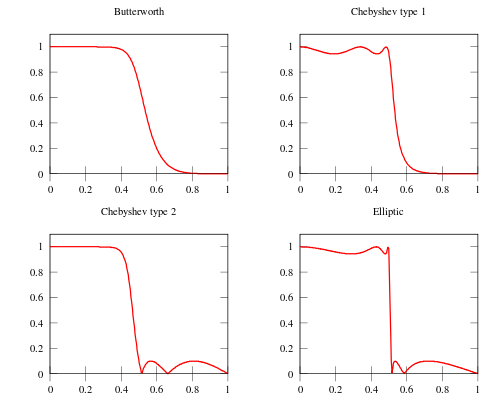Butterworth filter: Difference between revisions
Binksternet (talk | contribs) Undid revision 284537552 by 206.111.158.35 (talk) rv opaque 'monotonicity' which was unexplained |
→Maximal flatness: rewrite material inserted in lead in a more appropriate place |
||
| Line 132: | Line 132: | ||
:<math>\frac{dG}{d\omega}=-nG^3\omega^{2n-1}</math> |
:<math>\frac{dG}{d\omega}=-nG^3\omega^{2n-1}</math> |
||
which is |
which is [[monotonic]]ally decreasing for all <math>\omega</math> since the gain ''G'' is always positive. The gain function of the Butterworth filter therefore has no ripple. Furthermore, the series expansion of the gain is given by: |
||
:<math>G(\omega)=1 - \frac{1}{2}\omega^{2n}+\frac{3}{8}\omega^{4n}+\ldots</math> |
:<math>G(\omega)=1 - \frac{1}{2}\omega^{2n}+\frac{3}{8}\omega^{4n}+\ldots</math> |
||
In other words, all derivatives of the gain up to but not including the 2''n''-th derivative are zero, resulting in "maximal flatness". |
In other words, all derivatives of the gain up to but not including the 2''n''-th derivative are zero, resulting in "maximal flatness". If the requirement to be monotonic is limited to the passband only and ripples are allowed in the stopband, then it is possible to design a filter of the same order that is flatter in the passband than the "maximally flat" Butterworth. Such a filter is the [[inverse Chebyshev filter]]. |
||
===High-frequency roll-off=== |
===High-frequency roll-off=== |
||
Revision as of 09:49, 18 April 2009
This article includes a list of references, related reading, or external links, but its sources remain unclear because it lacks inline citations. (October 2008) |
| Linear analog electronic filters |
|---|
The Butterworth filter is one type of electronic filter design. It is designed to have a frequency response which is as flat as mathematically possible in the passband. Another name for them is 'maximally flat magnitude' filters.
The Butterworth type filter was first described by the British engineer Stephen Butterworth in his paper "On the Theory of Filter Amplifiers", Wireless Engineer (also called Experimental Wireless and the Wireless Engineer), vol. 7, 1930, pp. 536-541.

Overview
The frequency response of the Butterworth filter is maximally flat (has no ripples) in the passband, and rolls off towards zero in the stopband. When viewed on a logarithmic Bode plot, the response slopes off linearly towards negative infinity. For a first-order filter, the response rolls off at −6 dB per octave (−20 dB per decade) (all first-order filters, regardless of name, have the same normalized frequency response). For a second-order Butterworth filter, the response decreases at −12 dB per octave, a third-order at −18 dB, and so on. Butterworth filters have a monotonically changing magnitude function with ω. The Butterworth is the only filter that maintains this same shape for higher orders (but with a steeper decline in the stopband) whereas other varieties of filters (Bessel, Chebyshev, elliptic) have different shapes at higher orders.
Compared with a Chebyshev Type I/Type II filter or an elliptic filter, the Butterworth filter has a slower roll-off, and thus will require a higher order to implement a particular stopband specification. However, Butterworth filter will have a more linear phase response in the passband than the Chebyshev Type I/Type II and elliptic filters.
A simple example


A simple example of a Butterworth filter is the 3rd order low-pass design shown in the figure on the right, with farad, ohm, and henry. Taking the impedance of the capacitors C to be 1/Cs and the impedance of the inductors L to be Ls, where is the complex frequency, the circuit equations yields the transfer function for this device:
The magnitude of the frequency response (gain) is given by:
and the phase is given by:

The group delay is defined as the derivative of the phase with respect to angular frequency and is a measure of the distortion in the signal introduced by phase differences for different frequencies. The gain and the delay for this filter are plotted in the graph on the left. It can be seen that there are no ripples in the gain curve in either the passband or the stop band.
The log of the absolute value of the transfer function H(s) is plotted in complex frequency space in the second graph on the right. The function is defined by the three poles in the left half of the complex frequency plane. These are arranged on a circle of radius unity, symmetrical about the real s axis. The gain function will have three more poles on the right half plane to complete the circle.
By replacing each inductor with a capacitor and each capacitor with an inductor, a high-pass Butterworth filter is obtained. If we change each capacitor and inductor into a resonant capacitor and inductor in parallel, with the proper choice of component values, a band-pass Butterworth filter is obtained.
The transfer function

Like all filters, the typical prototype is the low-pass filter, which can be modified into a high-pass filter, or placed in series with others to form band-pass and band-stop filters, and higher order versions of these.
The gain of an n-order Butterworth low pass filter is given in terms of the transfer function H(s) as:
where
- n = order of filter
- ωc = cutoff frequency (approximately the -3dB frequency)
- is the DC gain (gain at zero frequency)
It can be seen that as n approaches infinity, the gain becomes a rectangle function and frequencies below ωc will be passed with gain , while frequencies above ωc will be suppressed. For smaller values of n, the cutoff will be less sharp.
We wish to determine the transfer function H(s) where . Since H(s)H(-s) evaluated at s = jω is simply equal to |H(jω)|2, it follows that:
The poles of this expression occur on a circle of radius ωc at equally spaced points. The transfer function itself will be specified by just the poles in the negative real half-plane of s. The k-th pole is specified by:
and hence,
The transfer function may be written in terms of these poles as:
The denominator is a Butterworth polynomial in s.
Normalized Butterworth polynomials
The Butterworth polynomials may be written in complex form as above, but are usually written with real coefficients by multiplying pole pairs which are complex conjugates, such as and . The polynomials are normalized by setting . The normalized Butterworth polynomials then have the general form:
- for n even
- for n odd
To four decimal places, they are:
|
Maximal flatness
Assuming and , the derivative of the gain with respect to frequency can be shown to be:
which is monotonically decreasing for all since the gain G is always positive. The gain function of the Butterworth filter therefore has no ripple. Furthermore, the series expansion of the gain is given by:
In other words, all derivatives of the gain up to but not including the 2n-th derivative are zero, resulting in "maximal flatness". If the requirement to be monotonic is limited to the passband only and ripples are allowed in the stopband, then it is possible to design a filter of the same order that is flatter in the passband than the "maximally flat" Butterworth. Such a filter is the inverse Chebyshev filter.
High-frequency roll-off
Again assuming , the slope of the log of the gain for large ω is:
In decibels, the high-frequency roll-off is therefore 20n dB/decade, or 6n dB/octave (The factor of 20 is used because the power is proportional to the square of the voltage gain; see 20 log rule.)
Filter design
There are a number of different filter topologies available to implement a linear analogue filter. These circuits differ only in the values of the components, but not in their connections.
Cauer topology

The Cauer topology uses passive components (shunt capacitors and series inductors) to implement a linear analog filter. The Butterworth filter having a given transfer function can be realised using a Cauer 1-form. The kth element is given by:
- ; k = odd
- ; k = even
The filter may start with a series inductor if desired, in which case the are k odd and the are k even.
Sallen-Key topology

The Sallen-Key topology uses active and passive components (op amps and capacitors) to implement a linear analog filter. Each Sallen-Key stage implements a conjugate pair of poles; the overall filter is implemented by cascading all stages in series. If there is a real pole (in the case where is odd), this must be implemented separately, usually as an RC circuit, and cascaded with the op-amp stages.
The Sallen-Key transfer function is given by
We wish the denominator to be one of the quadratic terms in a Butterworth polynomial. Assuming that , this will mean that
and
This leaves two component values undefined, which may be chosen at will.
Digital implementation
Digital implementations of Butterworth filters often use bilinear transform or matched z-transform to discretize an analog filter. For higher orders, they are sensitive to quantization errors. For this reason, they are often calculated as cascaded biquad sections and a cascaded first order filter, for odd orders.
Comparison with other linear filters
Here is an image showing the gain of a discrete-time Butterworth filter next to other common filter types. All of these filters are fifth-order.

The Butterworth filter rolls off more slowly around the cutoff frequency than the others, but shows no ripples.



















![{\displaystyle B_{n}(s)=\prod _{k=1}^{\frac {n}{2}}\left[s^{2}-2s\cos \left({\frac {2k+n-1}{2n}}\,\pi \right)+1\right]}](https://wikimedia.org/api/rest_v1/media/math/render/svg/187e9a2c6bc7c89f6130001674b6b6b352ed096f)
![{\displaystyle B_{n}(s)=(s+1)\prod _{k=1}^{\frac {n-1}{2}}\left[s^{2}-2s\cos \left({\frac {2k+n-1}{2n}}\,\pi \right)+1\right]}](https://wikimedia.org/api/rest_v1/media/math/render/svg/8353ee9b21666bab79a2a0e72a76c5c097a832aa)














![{\displaystyle C_{k}=2\sin \left[{\frac {(2k-1)}{2n}}\pi \right]}](https://wikimedia.org/api/rest_v1/media/math/render/svg/68f23aa51ad46a68f0cb9d82e2ed3235ef9ee49b)
![{\displaystyle L_{k}=2\sin \left[{\frac {(2k-1)}{2n}}\pi \right]}](https://wikimedia.org/api/rest_v1/media/math/render/svg/b083cc1dc88cd5443bc52baf7f229d1123322de7)





